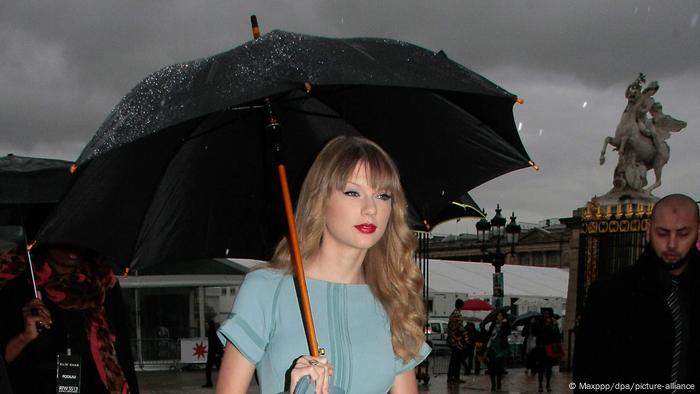A lot of technology is used at large concerts. How does it work when it rains? After all, electricity doesn't really get along with water.

Taylor Swift 2013 in Paris. Umbrellas are not practical at a concert.
Even before US singer Taylor Swift entered the stage at Gillette Stadium in Foxborough near Boston for the twelfth concert of her Eras tour, it was pouring rain. No sign of nice May weather. And it didn't get any better. Swift performed in front of 65,000 fans at the packed football stadium, but before long it looked more like she was performing fully clothed in a shower.
“This is the rainiest rain concert ever!” exclaimed Swift to her fans. “When you stand with people in the pouring rain, you have this romantic feeling of togetherness.”
The audience, wrapped in rain capes, cheered enthusiastically. But despite all the romantic togetherness – how safe are open-air concerts with a huge stage show when it's pouring rain?
Special technology for open-air events
First things first: at a concert at the highest professional level like that of superstar Taylor Swift, there isn't much of a safety risk these days when it rains. That's what Benjamin Bernschütz and Axel Barwich, professors at the Technical University of Central Hesse say.
“Of course, there are always various components on stages that are not directly intended for outdoor use and that need special protection against rain and the effects of the weather,” says Bernschütz, an expert in event technology and energy supply. These components are then, for example, in protected areas on the stage, behind or under the stage, or in containers.
But some of the technology used at concerts is now also available in variants which can be used outdoors in heavy rain.
“Power distributors, for example, come with rubberized connectors for cables,” explains Bernschütz.
The degree to which the technology is protected from water (and also from dust) and is therefore suitable for outdoor use is specified with IP – the ingress protection rating. Lights or power distributors with protection class IP44 can withstand a light drizzle, components with protection class IP65 or higher can also be used outside in heavy rain without additional protective measures.
“In the last three or four years in particular, effect lights with these types of protection have come onto the market,” says Barwich, an event security expert. This also makes the lighting of rainy stage shows even safer.
In addition, there is another protective mechanism: the RCDs (residual current protective devices), small devices that have the nice name of residual current circuit breakers. All electrically conductive and potentially dangerous components that artists come into contact with at a concert are protected with an RCD.
For example, if water were to penetrate a guitar amplifier and current would flow through the instrument as a result , the RCD would register this and turn off the power supply so the artist wouldn't get an electric shock when touching the guitar.
And what about the instruments?
The electric guitar is even safer in heavy rain if it is not connected to the guitar amplifier via a cable in the first place. There is wireless technology for this, which is also used for radio microphones, for example. The artist wears a small transmitter on their belt that runs on batteries and sends the signal from the microphone or guitar to the amplifier. Guitar and microphone have no electrical connection to the power supply network and can therefore not be “live”.
The risk of an electric shock no longer exists. But that doesn't mean that you can easily expose such instruments to hours of downpour. The piano that Swift played at her rainy concert in mid-May held up throughout the evening, but when Swift tried to play it at the concert the following evening, it suddenly jingled to herself without her doing.
“It rained for three and a half hours yesterday and it's getting worse,” Swift said apologetically. “That obviously broke the keys. I don't know how any of the instruments worked at all last night.”
Beware of smaller gigs
For a star like Taylor Swift, whose concerts attract tens of thousands of people, there is an almost inexhaustible budget for weatherproofing the stage equipment. A whole team of experts takes care of nothing else. This is not the case for lesser-known performers. Artists must therefore be particularly careful at private events and smaller performances.
In the online music forum “The Gear Page”, members also discuss the question of how safe it is to perform in the rain. One user writes: “In my opinion, if you're a big star who sold 30,000 tickets for a concert and all the people show up despite the rain, play. But otherwise go home.”
Another user shares his electrifying experience at a rainy gig: “I played at a wedding reception about ten years ago and it was pouring rain. We were under a tent but the floor and everything got soaking wet and I could feel the electricity flowing through my guitar strings.” If the instrument is already powered, there is nothing more to do. “I canceled the gig, dried my equipment and took everything away.”